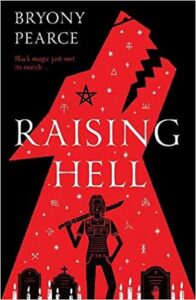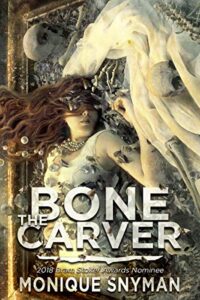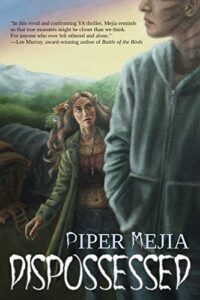Raising Hell by Bryony Pearce
UClan Publishing, 2021
ISBN-13 : 978-1912979547
Available: Paperback ( Amazon.com.uk )
Four years ago Ivy Mann and her friends Danny and Elena did a ritual to raise their friend Violet from the dead. Violet came back as a revenant and killed Danny before Ivy was able to stop her, and the ritual opened a rift that gives teenagers the ability to spellcast, bringing demons and hellhounds through and raising the dead. Ivy has been abandoned by her parents and Elena, her only company a cat possessed by the spirt of her Gran. Now nineteen, she works as a security guard at her old high school, detecting and confiscating magical contraband to protect other kids. In the case of Norah Ortega, she is too late to stop Norah from manifesting hellhounds in the school hallway. Although she defeats the hellhounds, she accidentally gives Norah a concussion, and Norah’s wealthy older brother Nicholas demands that Ivy be fired. Returning home, her Gran insists that Danny is there.
Then Norah shows up at Ivy’s place, asking for help. She is still connected to one of the hellhounds and it is draining her life force away. Nicholas follows shortly, and after surviving another hellhound attack, the three of them are off on a journey, chauffered by Nicholas’ bodyguard Andrews. Norah has to stay on consecrated ground, so Ivy, Nicholas, and Andrews go off to find the mysterious store where Norah got her spellbook, in hopes that the spell can be reversed, and discover Elena, who has found a way to bring Danny back because she believes that the three of them must all be there to reverse the ritual and close the rift. In the meantime, she’s sold an awful lot of copies of the Necronomicon to unstable teenagers intent on raising the dead. What could possibly go wrong?
This fast-paced urban fantasy doesn’t make a lot of sense, but it is a lot of fun and it contained some unexpected surprises, including a political subplot that will probably be better appreciated by residents of England. There’s a fair amount of blood, dead teenagers, and zombie gore– Ivy is not a perfect heroine or superpowered, and she isn’t able to prevent collateral damage from taking place– but she’s funny (her machete is named Matilda), no-nonsense, and kicks butt. Pearce did a great job bringing her character to life. Pearce’s teenagers are a mix of unlikable and sympathetic– regardless of her previous actions, Norah is grieving the death of her sister– which is pretty realistic, and something I appreciated.
The one thing that was really strained was Pearce’s attempt to push Ivy and Nicholas together romantically. Not only did he get her fired over his sister’s actions, but their own interactions weren’t romantic and they had no chemistry. It looks like Pearce has set things up for a sequel, so maybe that will be developed a little more, but that romance has a lot to overcome in order to be convincing. Raising Hell may be enjoyed by young adults who enjoy energetic urban fantasy with a dark edge.
Contains: blood, violence, zombie gore, self-harm
Reviewed by Kirsten Kowalewski







Follow Us!